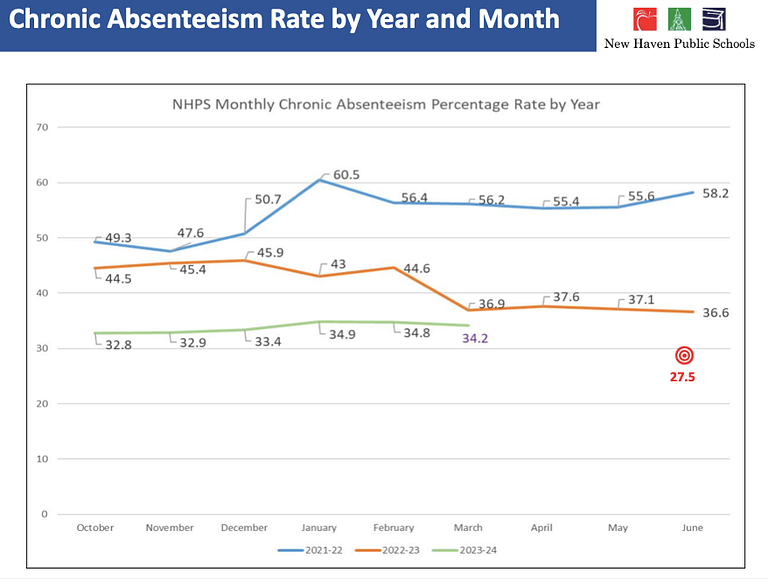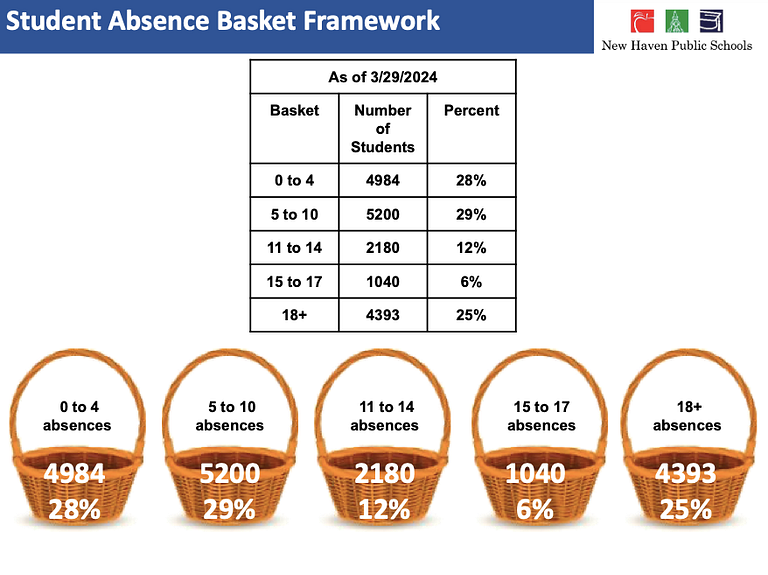
NHPS
End of March NHPS chronic absenteeism data.
Thirty four percent of New Haven Public Schools (NHPS) students have missed at least 10 percent of school days — a slight decline from the district’s January peak, but still above the district’s end-of-year chronic absenteeism goal of 27.5 percent.
That update was provided by schools Superintendent Madeline Negrón and NHPS Chief of Youth, Family and Community Engagement Gemma Joseph-Lumpkin during a presentation to the Board of Education Monday afternoon.
The hybrid Board meeting was hosted in-person at Ross Woodward School and via Zoom.
The district’s chronic absenteeism rates have fluctuated slightly throughout the school year. As of the end of March, that number is at 34.2 percent. By state standards, a student is chronically absent when they miss 10 percent or more of the total number of school days for which they’ve been enrolled.
Click here to view the presentation.
This time last school year the rate was at 36.9 percent, and the year before 56.2 percent. NHPS ended last school year with a chronic absenteeism rate of 36.6 percent.
In a school by school breakdown, absenteeism rates for K‑8 schools ranged from 10.1 percent to 47 percent. For high schools, they ranged from 12.8 percent to 93.2 percent.
Joseph Lumpkin noted that multiple schools are below where they were last year and that 57.9 percent of all schools are below the district’s total chronic absenteeism rate.
“Our challenge remains at the high school level,” she added. “We are continuing to understand what some of the issues are.”
The grade level breakdown shows that high school grades, specifically ninth grade, with 48.35 percent, have the highest rates of absenteeism. However, kindergarten absenteeism is at 38.37 percent, which is next highest after all high school grades.
Homeless NHPS students — who make up 1,010 students in total — have an absenteeism rate of 57 percent so far. “Some of those students are within private and charter schools but we are required by federal law to service those students. 884 of those students are within New Haven Public Schools,” Joseph Lumpkin explained.
A survey on absenteeism through Parent Link open from Sept. 1 to April 11 collected 4,095 responses from NHPS parents about the reasons for students missing school. The top two reasons were student illness, which 52.5 percent selected, and “other,” which included responses like parents waiting for physical exams, bullying, suspension, and death in the family.
Over the course of 1,933 home visits between February and March, district staff also heard from 822 families that their students were not showing up to class because they are disengaged and lack the motivation to attend school.
Joseph Lumpkin presented additional data that showed learner disengagement by grade level, which again highlights that ninth graders are the most disengaged followed by tenth and eleventh graders.
Another 790 families told staff that absences were due to medical concerns and the lack of required physicals and immunizations.
A combination of school, department, and community partner efforts has been helping the district to keep its numbers on the decline from reaching previous peaks.

In addition to presenting the absenteeism data update, Joseph Lumpkin invited three staffers to share about their experiences with dropout prevention work around the district.
Dropout prevention specialist Dania Torres shared her own story about being a single mother with a daughter who faced transportation, financial, and housing issues while at NHPS. Her daughter missed school because of doctor appointments and was picked up late because her work schedule conflicted with dismissal.
When connected with the dropout prevention team, Torres said an attendance plan was created that provided her with the resources of a school based clinic, made a referral for her daughter to attend LEAP’s after school program, connected her with Junta for Progressive Action to provide her with legal advice, and was invited to attend parent liaison workshops offering her groceries to feed her family.
When her daughter was in high school she was affected by the pandemic and she was again offered support by the dropout prevention team. Her daughter has since been awarded a New Haven Promise scholarship, attends the University of Connecticut, and will work at Yale University this summer. Torres concluded that these recent experiences of her inspired her to take on the job of a dropout prevention specialist for NHPS.
“We really take seriously this job,” Torres said.
Lincoln Bassett Principal Rosalind Garcia and Assistant Principal Eva Schultz shared about some methods the Newhallville preK‑6 school uses to encourage daily student attendance. Efforts ranged from having a daily 45-minute intervention block for students to get personalized supports to requiring every classroom for each grade to take students on two field trips a month.
Hillhouse community care coordinator Darrell Brown shared a story from this school year where he was assigned to a family of seven students that had been absent. “We could not find this family,” he said, due to addresses and phone numbers not being up to date.
Brown struggled to track the family down to figure out their needs until he learned that a family member worked in a local barbershop. Brown went to the barbershop and got contact information for the family and conducted a home visit.
Three of the seven children, ages 7, 6, and 5, had never attended school once. All of the students missed a total of 300 days of school in the last three years.
Brown connected them with wraparound services from Clifford Bears and the McKinney-Vento program. “We reengaged that family,” he said. “Care coordination is not giving the people the resources but teaching them not only how to find them but how to use them.”

Maya McFadden Photos
Clockwise: NHPS staffers Eva Schultz, Rosalind Garcia, Darrell Brown, and Dania Torres.
In response to Monday’s presentation, school board members suggested for future presentations on chronic absenteeism to further disaggregate the data to see more in-depth how homeless students are particularly supported, schools’ equivalency, and medical concerns that separate immunization issues from mental health related medical concerns.
“It’s not fair to compare Hillhouse or any comprehensive large urban high school with schools that are magnet schools and in many instances equivalent to many private schools,” Secretary Ed Joyner said.
Additionally, reengagement data was requested to see the number of students that have been reengaged after being absent for a period.








Another late Friday afternoon release of embarrassing information.
Typical political theatre.
Sad...on several levels.